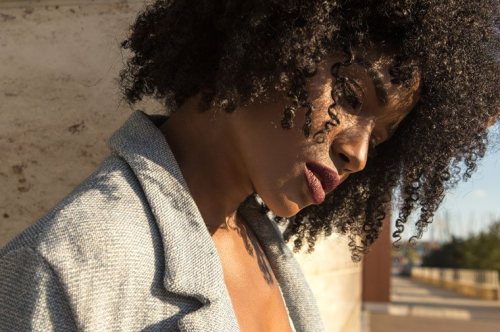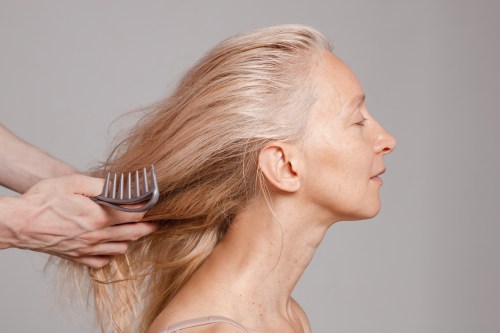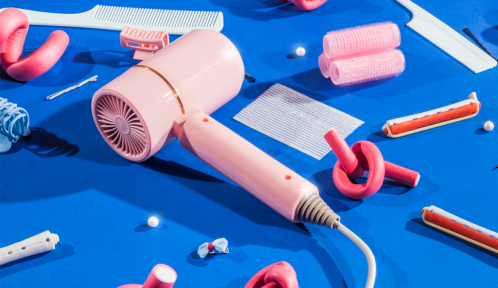The right way brush your hair, according to your texture
Your guide to brushing straight, curly and wavy hair, care of the experts.

Some of the most basic beauty rituals are actually the ones that can trip you up the most: like how often to shower and when or the correct way to brush your hair. It’s not exactly rocket science, but it turns out that there is a right way to detangle your tresses—and it all comes down to your texture.
If you hastily pass through strands, you could start chipping away at the outermost layer called the cuticle, which can lead to mega problems. “Brushing incorrectly can damage the hair shaft and cause breakage,” explains dermatologist Lily Talakoub, MD. Worse yet? She says that you can even potentially disrupt the follicles on your scalp, which might bring on hair thinning.
To avoid that, here, pros share their tips on the right ways to brush straight, wavy, and curly hair.
Keep reading for the solution for your hair type.
General rules
Brush from the bottom up. The thinking has always been that we should work from the roots to the tips, but according to Jana Blankenship, founder of natural hair-care brand Captain Blankenship, you should actually flip that logic. “[Starting at the scalp] really pulls at the follicle, which can lead to hair loss and breakage,” she says. By slowly detangling from the bottom up, you have more control, so you’re less likely to forcefully rip through hair.
Use a soft-bristled brush. Soft-bristled brushes, like those with boar hair, do your tips (the oldest, driest section of the strand) a major solid. They pick up the sebum from your scalp and distribute it down the hair shaft to help keep your ends softer and better conditioned. “It’s really important to use natural-bristled brushes or a wooden brushes instead of plastic-bristled ones, because they really do damage hair, damage the scalp, it’s way too harsh for hair,” says Blankenship.
Be cautious if you’re brushing wet: You know that rrrrriipping sound you hear when you brush your hair right after you get out of the shower? Yeah, that’s not ideal. Hair is extremely vulnerable when it’s wet, says Blankenship. To deal, reach for a wide-toothed comb (which has more space between teeth than bristles do) rather than a brush.

For pins
Women with pin-straight strands don’t have to brush vigorously, but instead, they just need to gently detangle any knots, suggests Talakoub. “Repeatedly pulling strands can break the fragile hair.” Basically, all you have to do is start at the ends and work your way up slowly, tackling one tangle at a time.

For waves
For healthy beach waves that last long after Labor Day, it’s all about the proper brushing tactic. “[This texture] often starts straight towards the scalp and crown of head and then gets a bend towards middle of hair and ends… I recommend using a wooden wide-toothed comb and gently detangling beginning at the bottom after conditioning,” says Blankenship. Keep shampooing to a minimum (think: three times per week) and use a sulfate-free formula. If you do need to style it dry (like when there isn’t time to shower after spin class), mist it lightly with some water and then use a natural-bristle brush.

For curls
Brushing through spirals the wrong way can knot hair and do some pretty major damage. “You have to be careful with curly hair because once you start doing too much brushing, or too much combing, hair can stretch,” says Aimee Sowu, co-Founder of hair-care brand Cue. While she notes that hair is elastic to a certain point, if the the narrower portions of the curl shaft endure too much friction and force, they’re more prone to breaking. She suggests combing through hair using a wide-toothed comb in small sections, beginning at the nape of the neck and working toward the hairline. To help the comb glide through hair more smoothly, apply a leave-in conditioner or hair oil.

For coils
“Often for those with kinky or coily hair, the process begins in the shower with ensuring the hair is well conditioned and that the conditioner has coated and worked its way onto all the hair strands,” explains Sowu. Working in small sections, she suggests beginning to detangle strands with fingertips while the conditioner is in, working from the bottoms up. Out of the shower, allow hair to dry a bit, then apply a hair oil or leave-in conditioner. To finish, use a wide-toothed comb or a brush designed for wet detangling and move from the tips towards the roots.
Healthy hair starts in the shower, but if the whole wash, rinse and repeat isn’t your thing, here are five places to start checking out apartments because rocking dirty hair is fully in style.
Sign Up for Our Daily Newsletter
Get all the latest in wellness, trends, food, fitness, beauty, and more delivered right to your inbox.
Got it, you've been added to our email list.










